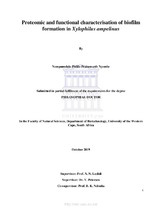| dc.description.abstract | Xylophilus ampelinus, the causal agent of bacterial blight of grapevine, inhabits the vascular tissues
of infected plants where the cells appear to form assemblages resembling biofilms. Bacterial blight
of grapevine affects vine-growing areas in Europe and parts of the Mediterranean, Japan, and South
Africa. Very little is known about the genetics and pathogenicity factors of the bacterium. The aim
of this study was to characterize the biofilm formation process of X. ampelinus through the analysis
of its biofilm proteome and functional characterization of the type IV pili (T4P). Biofilm formation
allows the bacteria to grow on surfaces, produce and respond to signals, and alter their phenotypes
through gene expression to promote adaptation and virulence. To characterize the biofilms formed
by X. ampelinus, an in vitro biofilm formation assay was used to identify the stages of biofilm
formation. The four major stages of biofilm formation identified, namely attachment, initial
biofilm (micro-colony) formation, biofilm maturation, and dispersal, occurred at day three, fiveseven,
ten, and fifteen, respectively. When comparing the protein profiles from the initial and
mature biofilm stages against the planktonic culture protein profile, 254 spots - showing a twofold
change - were considered to be differentially expressed. Out of 99 differentially expressed
proteins selected for identification, fifty-nine protein spots yielded 82 protein identities that were
assigned to seven functional categories including cellular processes, environmental adaptation,
environmental information processing, genetic information processing, metabolism, membrane
transport, and proteins of unknown function. Most proteins involved in genetic information
processing were induced in abundance during both stages of biofilm formation whereas most
proteins involved in carbohydrate, amino acid, and energy metabolism were reduced. Among the
proteins identified, a PAS domain S-box-containing protein/diguanylate cyclase (GGDEF)-like
protein was induced during the initial biofilm stage, while an indication that X. ampelinus biofilm
formation process and regulation require the secondary messenger cyclic di-GMP, this was further
confirmed by detection of proteins involved in two of the c-di-GMP-targeted pathways required
for cellulose and poly-N-acetylglucosamine (PNAG) biosynthesis. Bioinformatic analysis also
identified five proteins with similarity to the proteins encoded in the rpf (regulation of
pathogenicity factors) cluster of phytobacteria, which are required for DSF quorum-sensing signal
synthesis and perception. Furthermore, the role of T4P in attachment and biofilm formation was
identified through the functional characterization of six X. ampelinus genes, namely pilA, pilB,
http://etd.uwc.ac.za/
II
pilC, pilD, pilQ, and pilU. Scanning transmission electron microscopy (STEM) showed that pilA,
pilB, pilC, pilD, and pilQ genes are indispensable in the biogenesis and expression of T4P, while
the twitching motility gene, pilU, was not required for T4P expression. All T4P mutants showed
defects in the ability to twitch on agar surface under inducing conditions. Consequently, T4P
mutants (pilA, pilB, pilC, and pilD) were impaired in their ability to form biofilms in vitro while
pilQ and pilU mutants were not affected. In planta studies of the mutant and complemented T4P
strains showed that pilA, pilB, pilC, pilD, and pilQ deficient mutant strains were unable to form
biofilms both at the inoculation point (IP) and at distal parts from the IP, indicating that T4P are
required for host-surface colonization and establishment of bacteria inside the host plant. The pilU
mutant retained the wild-type phenotype in biofilm formation both in vitro and at the point of
inoculation in planta, however, the same mutant failed to form micro-colonies and biofilms at
distal parts from the IP indicating that the translocation of the cells across surfaces requires the
retraction function of the T4P that drives twitching motility. The observed role of T4P in biofilm
development inside plants and the reduced virulence exhibited by all the T4P mutants indicate that
T4P is required for in planta biofilm formation and surface colonization through twitching motility
and that T4P is required for the virulence of X. ampelinus in its host, grapevine. Together, the
biofilm proteome analysis and functional characterization of X. ampelinus T4P provide new
insights into biofilm formation, its regulation and contribution to the virulence of X. ampelinus. | en_US |

